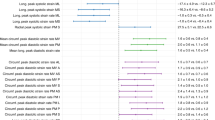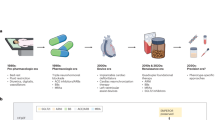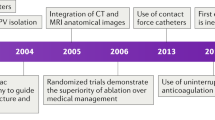Abstract
To mark the 10th anniversary of Nature Reviews Cardiology in November 2014, five of our Advisory Board members were invited to consider a topic within cardiology about which we know too little. A diverse range of subjects are highlighted in this Perspectives article, including preoperative assessment of right ventricular function, the burden of cardiomyopathies in Africa, the measurement of fractional flow reserve to guide coronary intervention, the interaction between genes and environment in cardiovascular disease, and the difficulty of predicting atherosclerotic plaque rupture. The five key opinion leaders from around the globe also suggest ways in which future research could be targeted to address the deficits in our understanding, with the aim of preventing cardiovascular disease, improving patient care, and reducing morbidity and mortality.
This is a preview of subscription content, access via your institution
Access options
Subscribe to this journal
Receive 12 print issues and online access
$209.00 per year
only $17.42 per issue
Buy this article
- Purchase on Springer Link
- Instant access to full article PDF
Prices may be subject to local taxes which are calculated during checkout




Similar content being viewed by others
Change history
25 September 2014
In the version of this article initially published online, Seung-Jung Park’s name was misspelled in the contributors’ biographies on page 2. The error has been corrected for the print, HTML, and PDF versions of the article.
References
Kaul, T. K. & Fields, B. L. Postoperative acute refractory right ventricular failure: incidence, pathogenesis, management and prognosis. Cardiovasc. Surg. 8, 1–9 (2000).
Haddad, F., Doyle, R., Murphy, D. J. & Hunt, S. A. Right ventricular function in cardiovascular disease, part II: pathophysiology, clinical importance, and management of right ventricular failure. Circulation 117, 1717–1731 (2008).
Reichert, C. L. et al. Prognostic value of biventricular function in hypotensive patients after cardiac surgery as assessed by transesophageal echocardiography. J. Cardiothorac. Vasc. Anesth. 6, 429–432 (1992).
Pinzani, A. et al. Pre- and postoperative right cardiac insufficiency in patients with mitral or mitral-aortic valve diseases [French]. Arch. Mal. Coeur Vaiss. 86, 27–34 (1993).
Maslow, A. D. et al. Precardiopulmonary bypass right ventricular function is associated with poor outcome after coronary artery bypass grafting in patients with severe left ventricular systolic dysfunction. Anesth. Analg. 95, 1507–1158 (2002).
Haddad, F. et al. Right ventricular myocardial performance index predicts perioperative mortality or circulatory failure in high-risk valvular surgery. J. Am. Soc. Echocardiogr. 20, 1065–1072 (2007).
Ochiai, Y. et al. Predictors of severe right ventricular failure after implantable left ventricular assist device insertion: analysis of 245 patients. Circulation 106 (Suppl. 1), I198–I202 (2002).
Mertens, L. L. & Friedberg, M. K. Imaging the right ventricle—current state of the art. Nat. Rev. Cardiol. 7, 551–563 (2010).
Friedberg, M. K. & Redington, A. N. Right versus left ventricular failure: differences, similarities, and interactions. Circulation 129, 1033–1034 (2014).
Vahanian, A. et al. Guidelines on the management of valvular heart disease (version 2012). Joint Task Force on the Management of Valvular Heart Disease of the European Society of Cardiology (ESC) and the European Association for Cardio-Thoracic Surgery (EACTS). Eur. Heart J. 33, 2451–2496 (2012).
Akinkugbe, O. O., Nicholson, G. D. & Cruickshank, J. K. Heart disease in blacks of Africa and the Caribbean. Cardiovasc. Clin. 21, 377–391 (1991).
Damasceno, A. et al. The causes, treatment, and outcome of acute heart failure in 1006 Africans from 9 countries: results of the Sub-Saharan Africa Survey of Heart Failure. Arch. Intern. Med. 172, 1386–1394 (2012).
Sliwa, K. & Mayosi, B. M. Recent advances in the epidemiology, pathogenesis and prognosis of acute heart failure and cardiomyopathy in Africa. Heart 99, 1317–1322 (2013).
Mocumbi, A. O., Ferreira, M. B., Sidi, D. & Yacoub, M. H. A population study of endomyocardial fibrosis in a rural area of Mozambique. N. Engl. J. Med. 359, 43–49 (2008).
Khogali, S. S. et al. A common mitochondrial DNA variant associated with susceptibility to dilated cardiomyopathy in two different populations. Lancet 357, 1265–1267 (2001).
Ntusi, N. B., Wonkam, A., Shaboodien, G., Badri, M. & Mayosi, B. M. Frequency and clinical genetics of familial dilated cardiomyopathy in Cape Town: implications for the evaluation of patients with unexplained cardiomyopathy. S. Afr. Med. J. 101, 394–398 (2011).
Shaboodien, G. et al. Prevalence of myocarditis and cardiotropic virus infection in Africans with HIV-associated cardiomyopathy, idiopathic dilated cardiomyopathy and heart transplant recipients: a pilot study. Cardiovasc. J. Afr. 23, 1–6 (2013).
Hilfiker-Kleiner, D. et al. A cathepsin D-cleaved 16 kDa form of prolactin mediates postpartum cardiomyopathy. Cell 128, 589–600 (2007).
Sliwa, K. et al. Evaluation of bromocriptine in the treatment of acute severe peripartum cardiomyopathy: a proof-of-concept pilot study. Circulation 121, 1465–1473 (2010).
Batchelder, K. & Mayosi, B. M. Pentoxifylline for heart failure: a systematic review. S. Afr. Med. J. 95, 171–175 (2005).
Ntusi, N. B., Badri, M., Gumedze, F., Wonkam, A. & Mayosi, B. M. Clinical characteristics and outcomes of familial and idiopathic dilated cardiomyopathy in Cape Town: a comparative study of 120 cases followed up over 14 years. S. Afr. Med. J. 101, 399–404 (2011).
D'Arbela, P. G., Mutazindwa, T., Patel, A. K. & Somers, K. Survival after first presentation with endomyocardial fibrosis. Br. Heart J. 34, 403–407 (1972).
Blauwet, L. A. et al. Predictors of outcome in 176 South African patients with peripartum cardiomyopathy. Heart 99, 308–313 (2013).
Karthikeyan, G. et al. Rationale and design of a Global Rheumatic Heart Disease Registry: the REMEDY study. Am. Heart J. 163, 535–540 (2012).
Mayosi, B. M. et al. Rationale and design of the Investigation of the Management of Pericarditis (IMPI) trial: a 2 × 2 factorial randomized double-blind multicenter trial of adjunctive prednisolone and Mycobacterium w immunotherapy in tuberculous pericarditis. Am. Heart J. 165, 109–115.e3 (2013).
Mayosi, B. M. The 10 'Best Buys' to combat heart disease, diabetes and stroke in Africa. Heart 99, 973–974 (2013).
Gould, K. L., Lipscomb, K. & Hamilton, G. W. Physiologic basis for assessing critical coronary stenosis. Instantaneous flow response and regional distribution during coronary hyperemia as measures of coronary flow reserve. Am. J. Cardiol. 33, 87–94 (1974).
White, C. W. et al. Does visual interpretation of the coronary arteriogram predict the physiologic importance of a coronary stenosis? N. Engl. J. Med. 310, 819–824 (1984).
Wijns, W. et al. Guidelines on myocardial revascularization: Task Force on Myocardial Revascularization of the European Society of Cardiology (ESC) and the European Association for Cardio-Thoracic Surgery (EACTS). Eur. Heart J. 31, 2501–2555 (2010).
Tonino, P. A. et al. Fractional flow reserve versus angiography for guiding percutaneous coronary intervention. N. Engl. J. Med. 360, 213–224 (2009).
De Bruyne, B. et al. Fractional flow reserve-guided PCI versus medical therapy in stable coronary disease. N. Engl. J. Med. 367, 991–1001 (2012).
Dattilo, P. B., Prasad, A., Honeycutt, E., Wang, T. Y. & Messenger, J. C. Contemporary patterns of fractional flow reserve and intravascular ultrasound use among patients undergoing percutaneous coronary intervention in the United States: insights from the National Cardiovascular Data Registry. J. Am. Coll. Cardiol. 60, 2337–2339 (2012).
Tonino, P. A. et al. Angiographic versus functional severity of coronary artery stenoses in the FAME study fractional flow reserve versus angiography in multivessel evaluation. J. Am. Coll. Cardiol. 55, 2816–2821 (2010).
Kang, S. J. et al. Usefulness of minimal luminal coronary area determined by intravascular ultrasound to predict functional significance in stable and unstable angina pectoris. Am. J. Cardiol. 109, 947–953 (2012).
Park, S. J. et al. Trends in the outcomes of percutaneous coronary intervention with the routine incorporation of fractional flow reserve in real practice. Eur. Heart J. 34, 3353–3361 (2013).
Joseph, P. G., Pare, G. & Anand, S. S. Exploring gene–environment relationships in cardiovascular disease. Can. J. Cardiol. 29, 37–45 (2013).
O'Donnell, C. J. & Nabel, E. G. Genomics of cardiovascular disease. N. Engl. J. Med. 365, 2098–2109 (2011).
Heath, A. C. et al. Zygosity diagnosis in the absence of genotypic data: an approach using latent class analysis. Twin Res. 6, 22–26 (2003).
Hunter, D. J. Gene–environment interactions in human diseases. Nat. Rev. Genet. 6, 287–298 (2005).
Kullo, I. J. & Ding, K., Mechanisms of disease: the genetic basis of coronary heart disease. Nat. Clin. Pract. Cardiovasc. Med. 4, 558–569 (2007).
Manly, K. F. Reliability of statistical associations between genes and disease. Immunogenetics 57, 549–558 (2005).
Reich, D. & Patterson, N. Will admixture mapping work to find disease genes? Philos. Trans. R. Soc. Lond. B Biol. Sci. 360, 1605–1607 (2005).
Do, R. et al. The effect of chromosome 9p21 variants on cardiovascular disease may be modified by dietary intake: evidence from a case/control and a prospective study. PLoS Med. 8, e1001106 (2011).
Ordovas, J. M., Robertson, R. & Cleirigh, E. N. Gene–gene and gene–environment interactions defining lipid-related traits. Curr. Opin. Lipidol. 22, 129–136 (2011).
Serre, D. et al. Correction of population stratification in large multi-ethnic association studies. PLoS ONE 3, e1382 (2008).
Deitz, A. C. et al. Impact of misclassification in genotype-exposure interaction studies: example of N-acetyltransferase 2 (NAT2), smoking, and bladder cancer. Cancer Epidemiol. Prev. 13, 1543–1546 (2004).
Kilpelainen, T. O. et al. Physical activity attenuates the influence of FTO variants on obesity risk: a meta-analysis of 218,166 adults and 19,268 children. PLoS Med. 8, e1001116 (2011).
Marteau, T. M. et al. Effects of communicating DNA-based disease risk estimates on risk-reducing behaviours. Cochrane Database Systematic Reviews, Issue 10. Art. No.: CD007275. http://dx.doi.org/10.1002/14651858.CD007275.pub2.
Guttmacher, A. E. et al. The family history more important than ever. N. Engl. J. Med. 351, 2333–2336 (2004).
Fletcher, B. J. et al. Global cardiovascular disease prevention: a call to action for nursing, community-based and public health prevention initiatives. J. Cardiovasc. Nurs. 26 (Suppl.), S35–S45 (2011).
Burke, A. P. et al. Coronary risk factors and plaque morphology in men with coronary disease who died suddenly. N. Engl. J. Med. 336, 1276–1282 (1997).
Heron, M. Deaths: leading causes for 2008. Natl Vital Stat. Rep. 60, 1–94 (2012).
Finn, A. V., Nakano, M., Narula, J., Kolodgie, F. D. & Virmani, R. Concept of vulnerable/unstable plaque. Arterioscler. Thromb. Vasc. Biol. 30, 1282–1292 (2010).
Stone, G. W. et al. A prospective natural-history study of coronary atherosclerosis. N. Engl. J. Med. 364, 226–235 (2011).
Greenland, P. et al. 2010 ACCF/AHA guideline for assessment of cardiovascular risk in asymptomatic adults: a report of the American College of Cardiology Foundation/American Heart Association Task Force on Practice Guidelines. J. Am. Coll. Cardiol. 56, e50–e103 (2010).
Kong, M. H. et al. Systematic review of the incidence of sudden cardiac death in the United States. J. Am. Coll. Cardiol. 57, 794–801 (2011).
WHO. Cardiovascular disease. The atlas of heart disease and stroke. Deaths from coronary heart disease [online], (2004).
Gerber, Y. et al. Secular trends in deaths from cardiovascular diseases: a 25-year community study. Circulation 113, 2285–2292 (2006).
Ng, M. et al. Global, regional, and national prevalence of overweight and obesity in children and adults during 1980–2013: a systematic analysis for the Global Burden of Disease Study 2013. Lancet http://dx.doi.org/10.1016/S0140-6736(14)60460-8.
Virmani, R., Kolodgie, F. D., Burke, A. P., Farb, A. & Schwartz, S. M. Lessons from sudden coronary death: a comprehensive morphological classification scheme for atherosclerotic lesions. Arterioscler. Thromb. Vasc. Biol. 20, 1262–1275 (2000).
Bentzon, J. F., Otsuka, F., Virmani, R. & Falk, E. Mechanisms of plaque formation and rupture. Circ. Res. 114, 1852–1866 (2014).
Otsuka, F., Sakakura, K., Yahagi, K., Joner, M. & Virmani, R. Has our understanding of calcification in human coronary atherosclerosis progressed? Arterioscler. Thromb. Vasc. Biol. 34, 724–736 (2014).
Rader, D. J. & Daugherty, A. Translating molecular discoveries into new therapies for atherosclerosis. Nature 451, 904–913 (2008).
Acknowledgements
N.S. acknowledges the University of British Columbia School of Population and Public Health, Vancouver, BC, Canada where she was undertaking a sabbatical while writing this manuscript.
Author information
Authors and Affiliations
Corresponding authors
Ethics declarations
Competing interests
The authors declare no competing financial interests.
Rights and permissions
About this article
Cite this article
Alfieri, O., Mayosi, B., Park, SJ. et al. Exploring unknowns in cardiology. Nat Rev Cardiol 11, 664–670 (2014). https://doi.org/10.1038/nrcardio.2014.123
Published:
Issue Date:
DOI: https://doi.org/10.1038/nrcardio.2014.123
This article is cited by
-
Macrophage profiling in atherosclerosis: understanding the unstable plaque
Basic Research in Cardiology (2024)
-
Cardiovascular events, diabetes and guidelines: the virtue of simplicity
Cardiovascular Diabetology (2019)
-
Association of serum microRNA-21 levels with Visfatin, inflammation, and acute coronary syndromes
Heart and Vessels (2017)
-
Contributions of risk factors and medical care to cardiovascular mortality trends
Nature Reviews Cardiology (2015)



